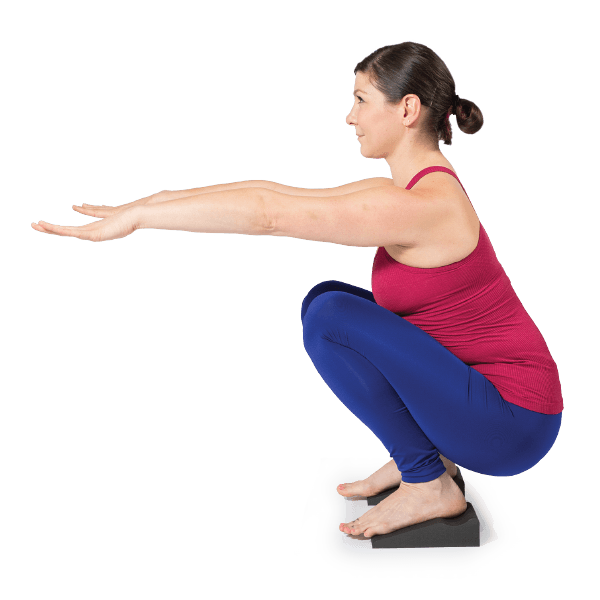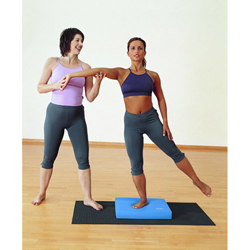Assuming the classic move is done correctly, it holds great potential beyond just stronger glutes and quadriceps. Its many benefits also include greater core strength and stability and improved hip mobility to name a few. It’s no wonder the squat is a trusted favorite among fitness experts, athletic trainers, physical therapists and movement specialists.
Development of a Training Tool
As someone with an affinity for rehabilitative exercise and fitness performance, I’ve made it my mission to understand as much as I can about squat mechanics. It’s become a passion of mine to try and make the squat safer and more effective for people of all abilities.
To help accomplish this, I set out to create an exercise tool that would aid those having difficulty accomplishing the squat movement. Nearly 35 years of professional development in the clinic and rigorous personal training and rehab in the gym led to a product that we now call the Performance Wedges™. And while this pair of foam wedges is a versatile companion for planks, pushups or balance-related moves, they’re especially valuable for assisting with the almighty squat.
Throughout my research and training observations, I’ve found that using the Performance Wedges with my clients can result in the following three benefits.
1. Improved Depth
The ankles are an area that can often have limited flexibility, which is usually due to tightness of the gastrocnemius or calf musculature. This limited ankle range of motion can restrict the ability to achieve proper squat depth. But tightness in the calves and lower leg can easily be addressed with stretching.
To do this, we start by positioning the Performance Wedges in the incline position. The heels are placed at the low end of the Wedges and the toes near the grooves. Standing in this position, lean forward slightly to stretch the calves, holding for 45 seconds and repeating for three sets. Reducing calf (and lateral lower leg) tightness in this way will encourage improved ankle mobility that will help with squat depth.

In addition to stretching, the Performance Wedges can be used for depth assistance during the squat itself. To achieve this, we place the Wedges in the decline position with the heels at the top of the Wedge in the grooves and the toes toward the floor. Performing your squats with this setup places the low back in a more vertical position and allows for increased flexion at the hip and knees1. This not only aids in squat depth performance but also decreases stress in the low back area and potentially makes the movement more comfortable at the knees, allowing the fuller range of motion to be accomplished with more comfort and ease.

2. Greater Muscle Activation
Like most other exercises, the squat can provide great results when performed properly. This includes increases in strength and muscle activation; both of which should be goals regardless if you’re an athlete aiming for hypertrophy or a patient rehabilitating from injury.
To achieve these benefits though, depth is key. Generally, taking your squat depth below parallel is going to provide greater muscle activation for the glutes, hamstrings, adductors and quads.
As illustrated previously, we can use the Performance Wedges in the decline position (heels placed at the top, toes toward the floor) during the squat to place the low back in a more vertical position. This can make the movement more comfortable at the knees and allow for that deeper range of motion that produces greater muscle activation.3
3. Protection for the Low Back and Knees
Of course, no exercise is valuable if it results in harm. Preventing injury or pain in the low back area has always been a primary concern of mine, and it’s one of the main reasons why I developed the Performance Wedges.
Using the Wedges in the decline position helps prevent medial collapse of the knees (which can cause ACL injury) and allows for increased flexion at the hip and knees3. This increased knee and hip range of motion helps prevent rounding of the low back, in turn decreasing stress on this area.
But it’s not just the back that benefits. With the increased hip range of motion, it becomes easier to keep the knees from migrating too far past the toes. This, along with the cushioned nature of the foam Wedges themselves, helps support the knee joints and increase comfort during exercise. (While it is important to note that studies do show an increased force on the knees when the spine is in a more vertical position, it is negligible and safer compared to the stress of having the knees travel too far out over the toes.)
Additionally, the increased range of motion aided by the Performance Wedges may also help prevent hyperextension of the knee and valgus (collapsing of the knee inward), actions that can lead to knee pain4,5.
I’ve had the privilege of seeing many unique exercise products throughout my career. But I can say, thanks to a lot of effort that went into the design of the Performance Wedges, that I feel especially confident recommending this product to anyone looking to enhance strength and functionality throughout the body. The simplicity of its design — just like the simplicity of the squat itself — has reminded me that sometimes in life, the simple things provide the most value.
-
Kim, S.-H., Kwon, O.-Y., Park, K.-N., Jeon, I.-C., & Weon, J.-H. (2015). “Lower Extremity Strength and the Range of Motion in Relation to Squat Depth.” Journal of Human Kinetics; 45, 59–69. http://doi.org/10.1515/hukin-2015-0007.
-
Soma, M., Murata, S., Kai, Y., Nakae, H., Satou, Y., Murata, J., & Miyazaki, J. (2015). “Kinematic analysis during toe-gripping strength exertion: angular changes in the ankle joint and leg muscle activities.” Journal of Physical Therapy Science; 27(6), 1957–1960. http://doi.org/10.1589/jpts.27.1957.
-
Hayley S. Legg, Mark Glaister, Daniel J. Cleather & Jon E. Goodwin (2016). “The effect of weightlifting shoes on the kinetics and kinematics of the back squat.” Journal of Sports Sciences; 35:5, 508-515, DOI: 10.1080/02640414.2016.1175652.
-
Ota, S. et al., “Acute influence of restricted ankle dorsiflexion angle on knee joint mechanics during gait.” The Knee; Volume 21, Issue 3, 669 – 675.
-
P. Tabrizi, W. M. J. McIntyre, M. B. Quesnel, A. W. Howard. “Limited dorsiflexion predisposes to injuries of the ankle in children.” The Journal of Bone and Joint Surgery [Br] 2000;82-B:1103-6. Received 21 April 1999; Accepted after revision 4 May 2000.
* Always consult with your healthcare provider before starting any new exercise program.
The Performance Wedges, available exclusively from OPTP, were invented by Dr. Greg DeNunzio and personal trainer Luis Leonardo. They’re sold as a pair and can be used singly or together for squats, pushups, planks and a wide variety of other exercises in fitness, physical therapy, Pilates or yoga.







